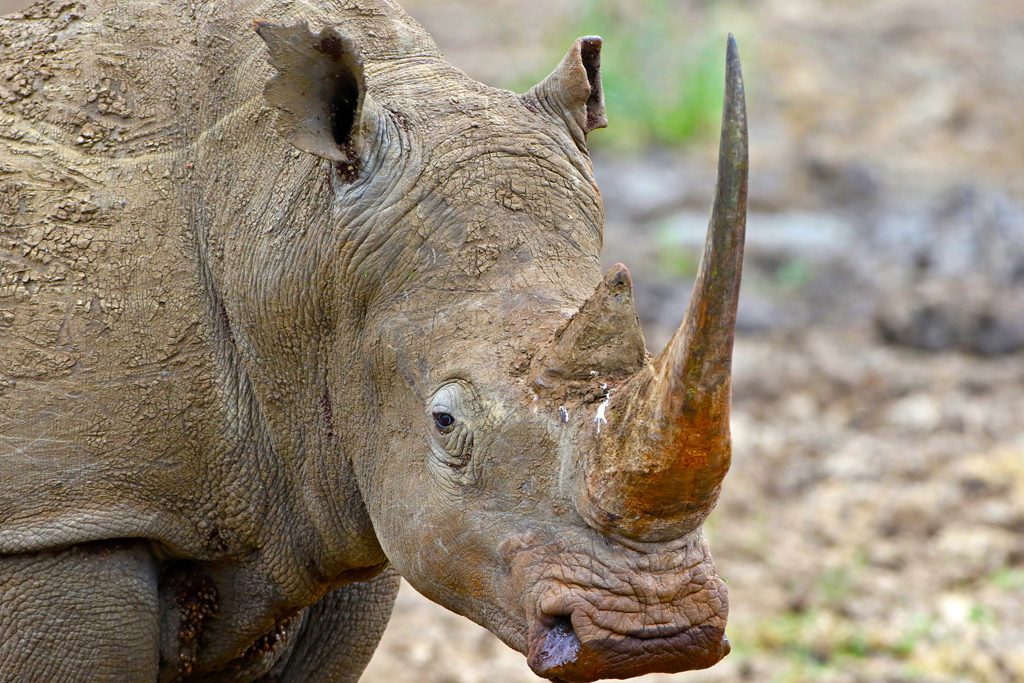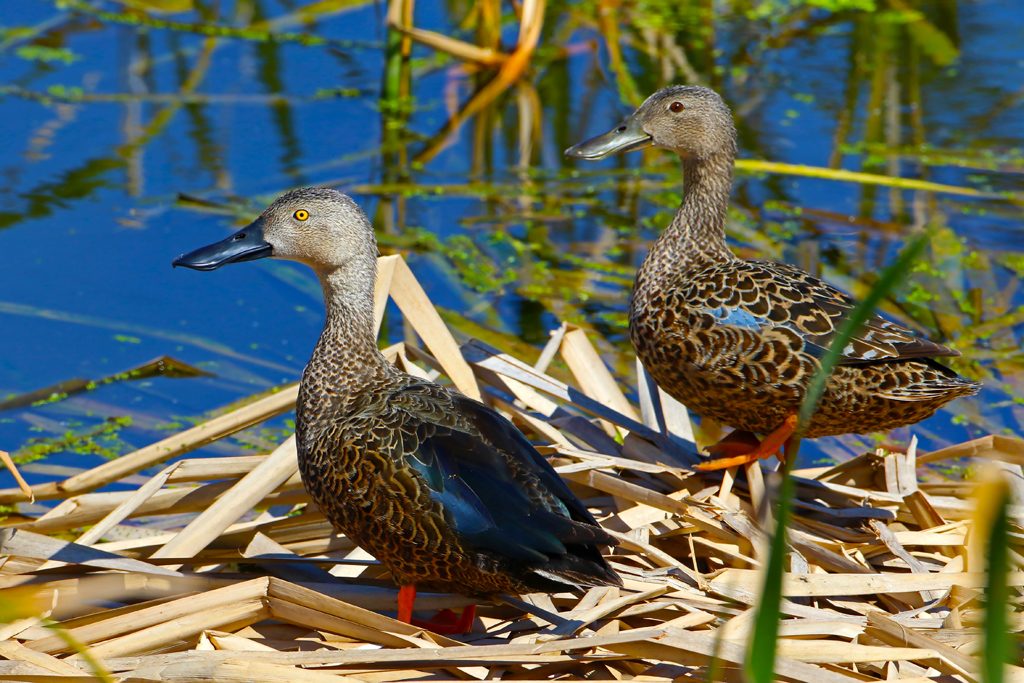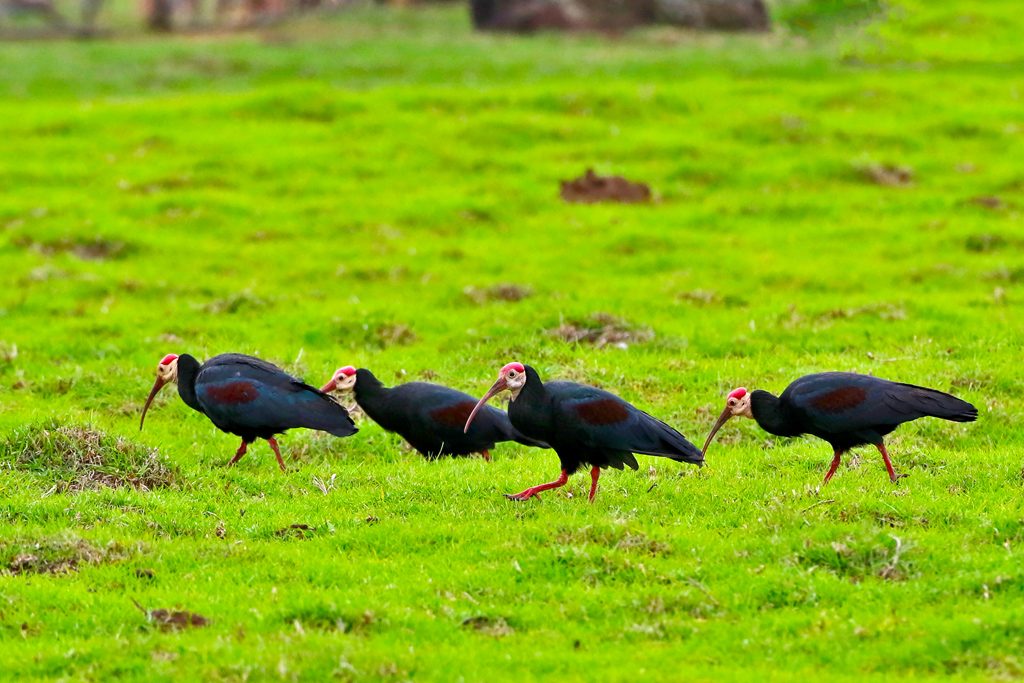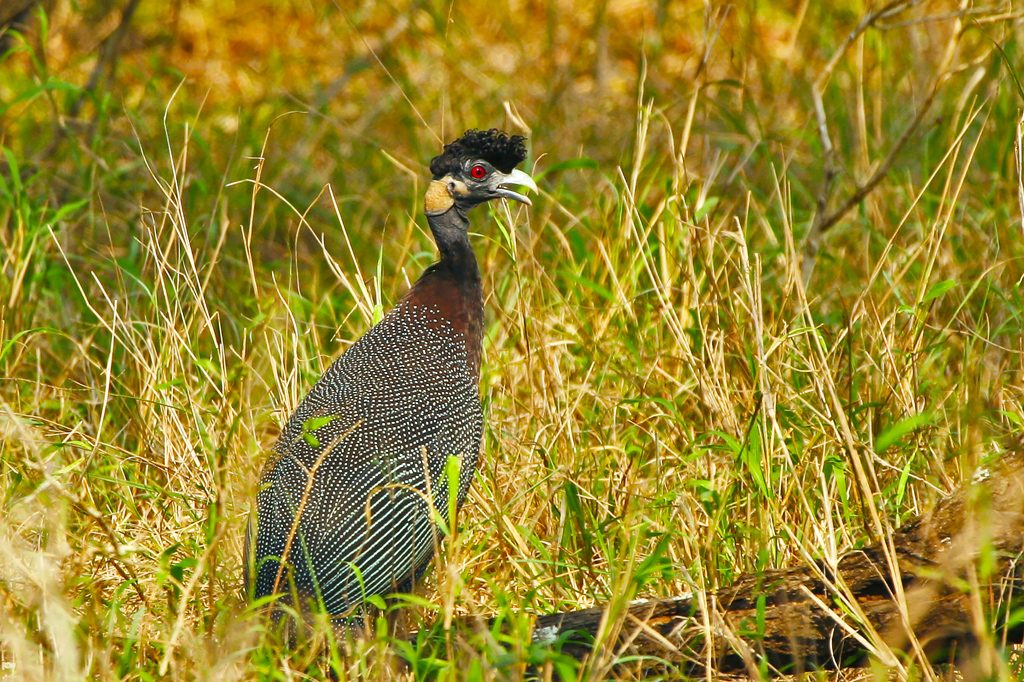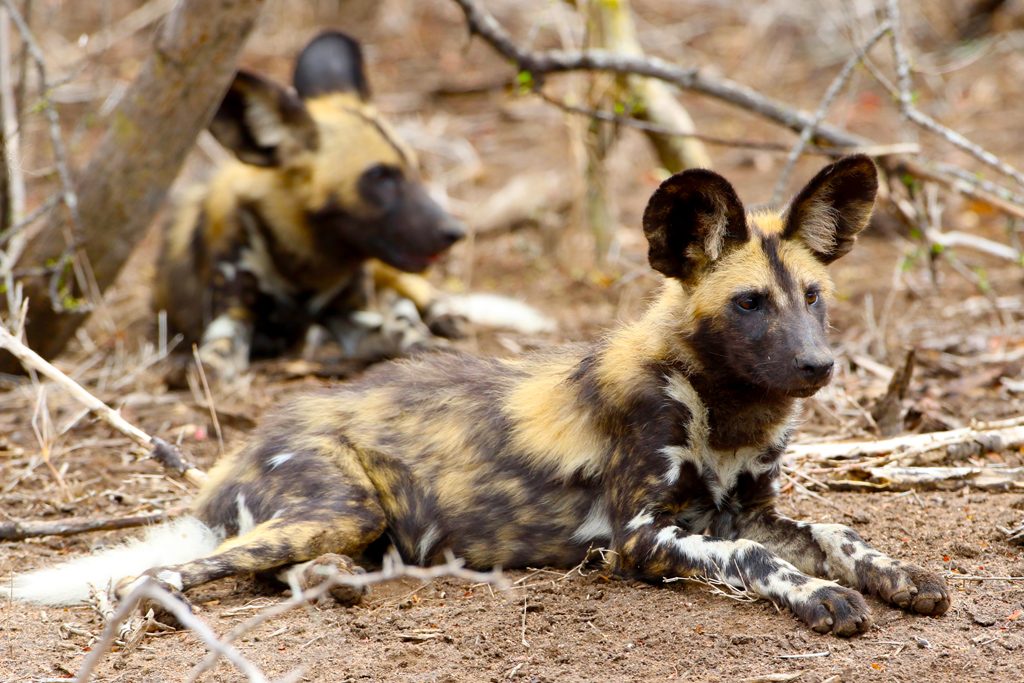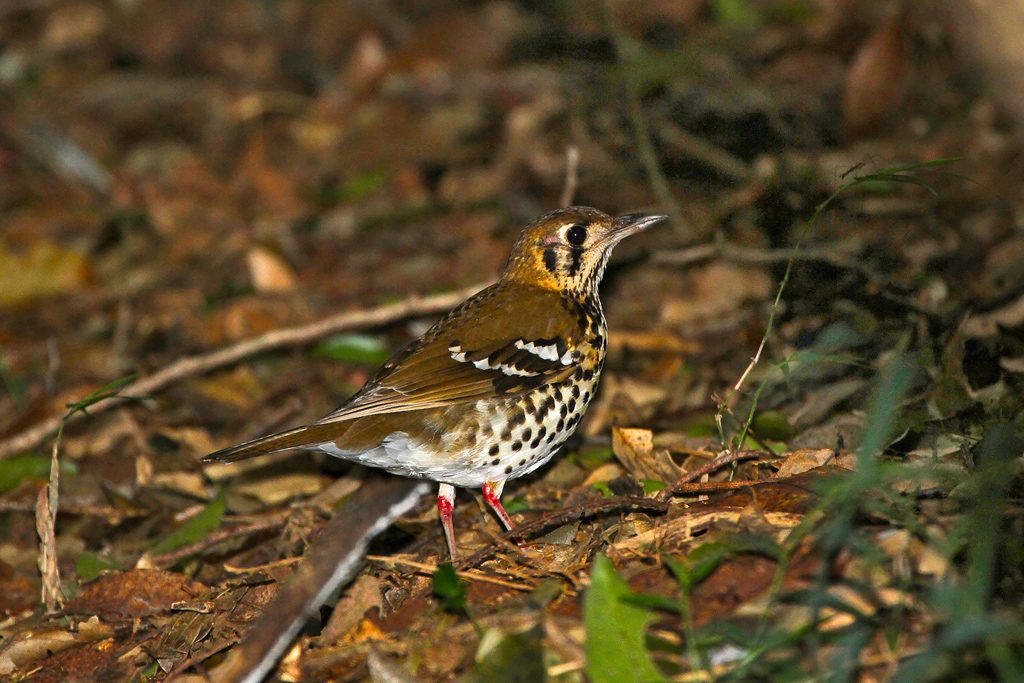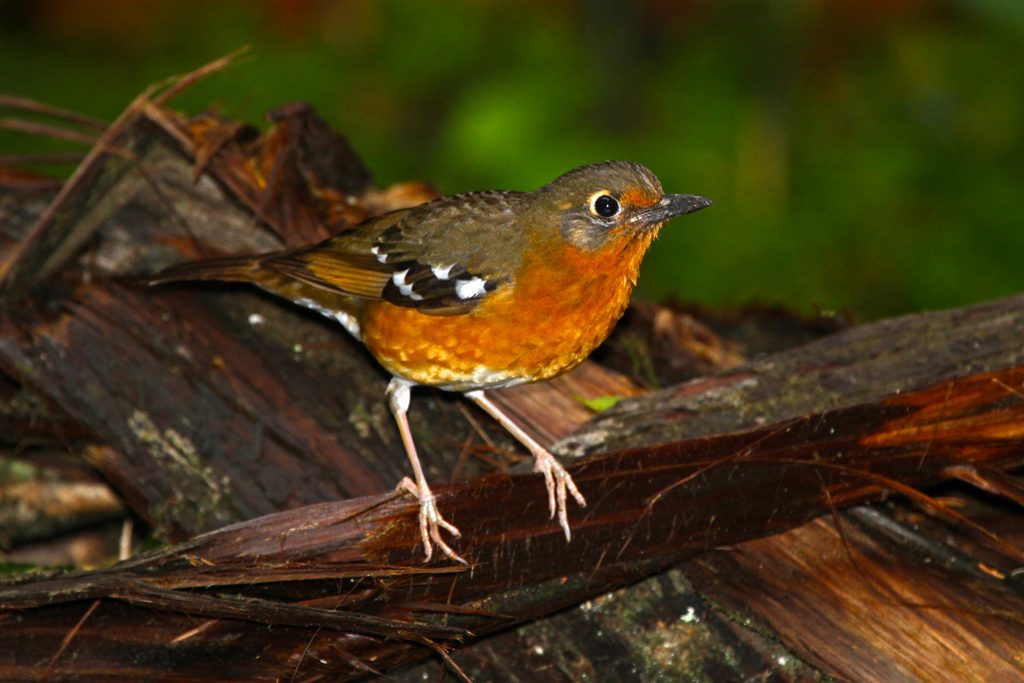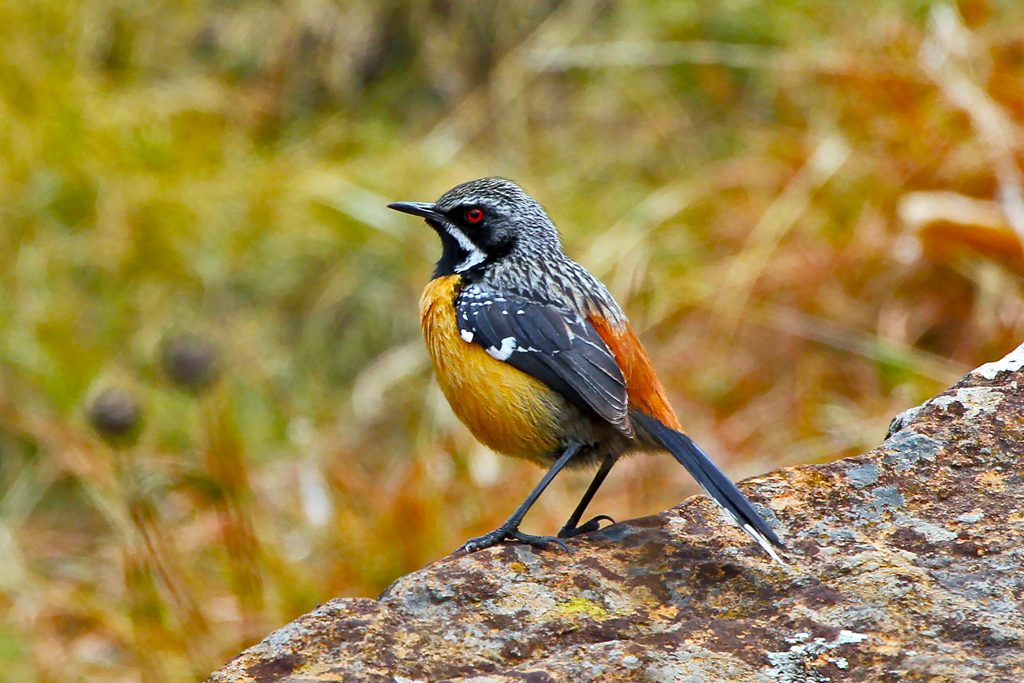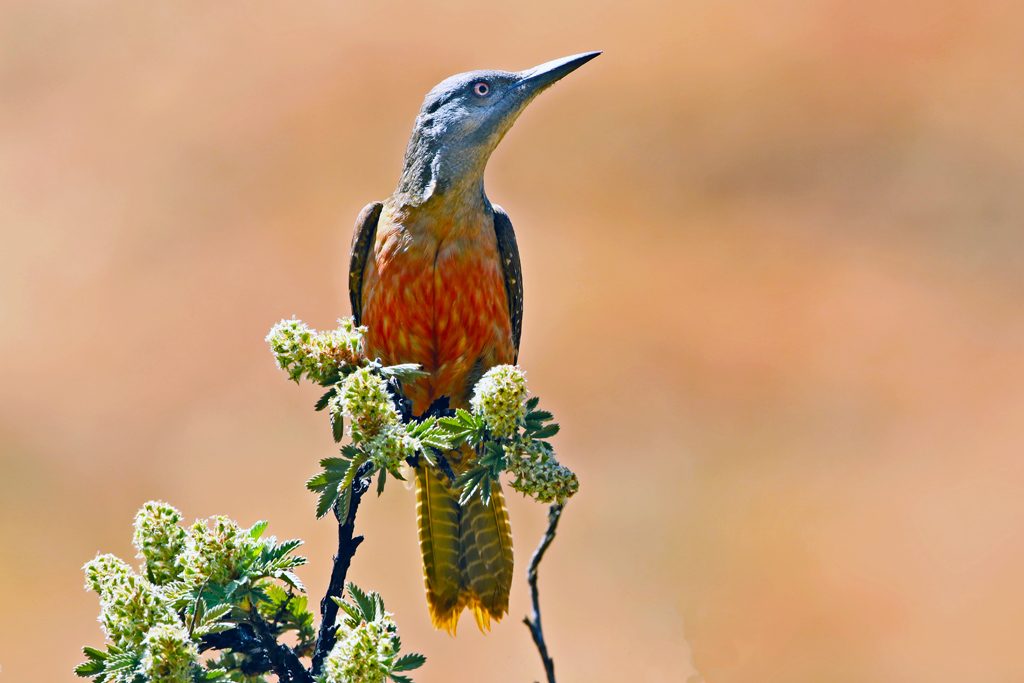Eastern South Africa Itinerary
| Intro | Itinerary | Tour Pricing and Information | Gallery | Birdlist | Registration |
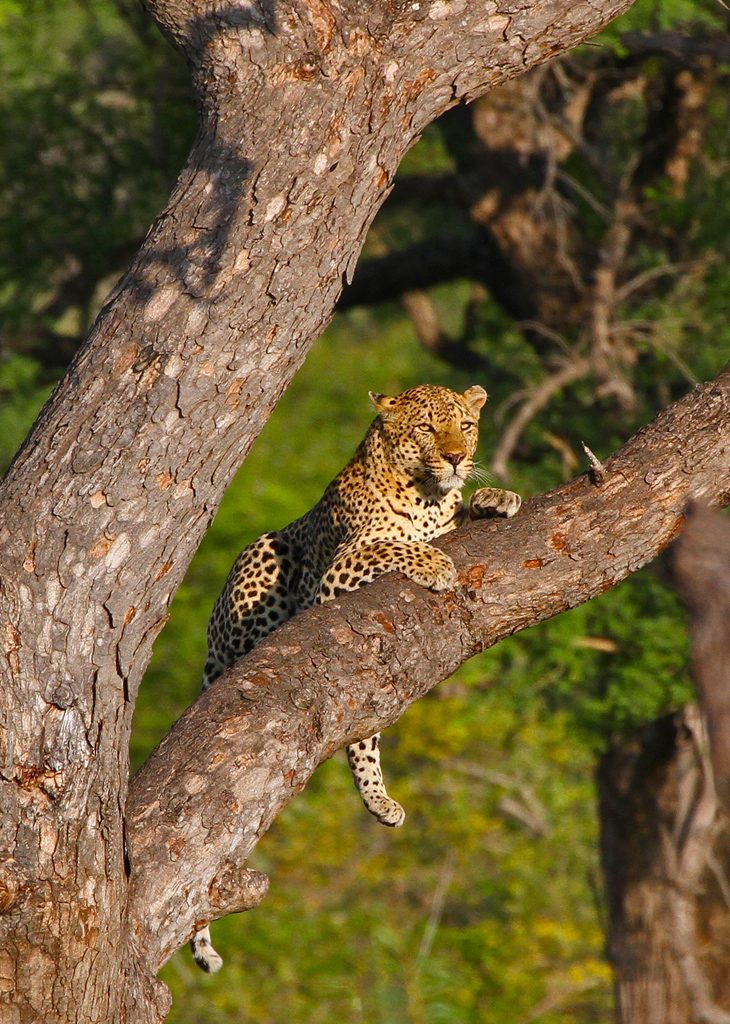 Leopard. Kruger National Park. Photo by Kim & Cindy Risen ©.
Leopard. Kruger National Park. Photo by Kim & Cindy Risen ©.Day 1, August 13, 2018: Arrival into Johannesburg. Group members arrive independently in Johannesburg. Most flights arrive in the early evening hours. If everyone’s flights run on time, you will be met at the airport by Kim Risen and we’ll transfer to our hotel for a good night’s sleep.
Day 2, August 14, 2018: Drive to Kruger National Park. After breakfast we depart for our exploration of the peerless Kruger National Park. Upon arrival in Kruger, we’ll enjoy a leisurely drive from the entrance gate to our home for the first two nights, Pretoriuskop Camp in the southern portion of this giant park. Night Kruger at Pretoriuskop Camp.
Day 3 – 7, August 15 – 19, 2018: Kruger National Park. We’ll spend the next five days exploring the world-famous Kruger National Park, one of Africa’s last great wildernesses, by safari vehicle! Elevated with ‘stadium’ type seating, these vehicles offer unmatched views of the birds and animals we find. We’ll be in “Big Five” (African Lion, African Elephant, Leopard, African Buffalo and White Rhinoceros) country every minute of our visit and, while searching for the special birds of the area, we have a good chance of seeing all of these impressive animals. Other highly sought after mammals we may find include Cheetah, African Wild Dog and Spotted Hyena. Mammals really do abound and we should have no difficulty in seeing Giraffe, Plain’s Zebra, Blue Wildebeest, Greater Kudu, Impala, Klipspringer, Bushbuck, Warthog, Chacma Baboon, Vervet Monkey and Dwarf Mongoose. Kruger National Park also provides us with fantastic birding opportunities. Of special note here are species requiring vast areas of wilderness, such as Ostrich, Kori Bustard—the world’s heaviest flying bird, Southern Ground Hornbill, Martial Eagle, Bateleur, Marabou and Saddle-billed storks and up to five species of vultures. Kruger National Park is a superb example of a healthy African savanna biome and the “classic” African families such as turacos, mousebirds, bee-eaters, kingfishers, rollers, woodhoopoes, hornbills, barbets, shrikes, starlings, widows, weavers and sunbirds are well represented. We expect to find a variety of examples of each of these families. Particular bird species that we will search for include Crested, Swainson’s, Shelley’s and Natal francolins, Shikra, Dark Chanting Goshawk, African Finfoot, Brown-headed Parrot, Verreaux’s Eagle Owl, Chestnut-backed Finchlark, African White-throated Robin-chat, Burnt-necked Eremomela, Southern White-crowned and Long-tailed (Magpie) shrikes and Red-billed Oxpecker, which favor the park’s large herbivores. We will do at least two night drives into the park exploring for nocturnal birds and mammals. Success on night drives varies greatly but the list of possibilities is rather impressive and includes the likes of Spotted and Giant Eagle-Owls, Barn, Marsh and Southern White-faced Owl, Pearl-spotted and African Barred Owlets, Square-tailed and Fiery-necked Nightjars, Bronze-winged Courser, both Large and Small Spotted Genets, Lesser and Greater Galago, African Wild Cat, African Civet, Serval and Spotted Hyena, besides the Big 5! Nights Kruger (Pretoriuskop, Olifants, Olifants, Satara and Satara Camps)
White Rhinoceros. Kruger National Park. Photo by Kim & Cindy Risen ©.
Day 8, August 20, 2018: Kruger to Wakkerstroom. One last morning to enjoy the wonders of Kruger National Park. Our route for the morning will depend upon what animals/birds we might still want to see and weather conditions. We are likely to spend the morning along the river banks enroute to Skukuza Camp. We’ll enjoy breakfast at Skukuza before departing this most amazing national park for the high grasslands surrounding Wakkerstroom. This quaint village is surrounded by pristine upland grasslands rich in endemic birds many of which are currently threatened by the ongoing destruction of their grassland habitat.
We hope to arrive in time to spend the late afternoon birding the highly productive Wakkerstroom marsh at the edge of town, which is a haven for waterbirds and offers the chance of a number of uncommon or localized endemics. A series of photo hides often allow spectacularly close experiences. Purple Heron, South African Shelduck, Cape Shoveler, Purple Swamphen, African Rail, South African Cliff Swallow, Levaillant’s Cisticola, Lesser Swamp-Warbler and Cape Weaver are all regular and we should find African Snipe and Little Bittern. Rarely recorded species seen here on our previous trips include the elusive Baillon’s Crake and Red-chested Flufftail.
African Shoveler. Photo by Kim & Cindy Risen ©.
I’ve increased our recent tradition of a one night stay into a two night stay so that we can enjoy more time at a fabulous facility and a region that hosts a number of rare, endangered and spectacular birds. If anyone in the group doesn’t want to join us in early morning birding either day, they can sleep in as we’ll be back for breakfast. This is one of our few ‘Pure Birding’ mornings…but there are some very rare and cool birds to look for! We stay at a charming, historic B & B called Wetlands Country House & Sheds. A beautiful place to be based during our time in these high grasslands. This year’s two night stay insures we have as much time as possible to take it all in! Night Wakkerstroom.
Day 9, August 21, 2018: Wakkerstroom Region. We’ll spend our time in these beautiful grasslands driving along a network of dirt roads radiating out from Wakkerstroom. Wandering about exploring grasslands, rocky outcrops and gorges in search of Southern Bald Ibis, Stanley, Blue and Southern White-bellied Bustard, Blue Crane, the bizarre Ground Woodpecker, the rare and localized Botha’s and Rudd’s Lark (the latter considered the world’s most threatened lark and classified as critically endangered), Sentinel Rock-Thrush, Buff-streaked Chat, Yellow-tufted and Yellow-breasted Pipit, the spectacular Long-tailed Widowbird, Yellow-crowned and Southern Red Bishop and African Quailfinch.
Southern Bald Ibis. Photo by Kim & Cindy Risen ©.
We’ll encounter a few mammals along the way, many of the farms in the area around Wakkerstroom support populations of the peculiar Black Wildebeest (also known by its less-used English name of White-tailed Gnu) and Blesbok, while smaller mammals occurring in the grasslands include Yellow Mongoose and the rare Cape Fox. One of the other interesting denizens of these grasslands is the curious Suricate or Meerkat, immortalized in the Lion King. We have a good chance of finding family groups of these unusual animals. Night Wakkerstroom.
Day 10, August 22, 2018: Wakkerstroom drive to Mkuze. A final morning to search for any species missing from our lists. After breakfast we’ll turn southward to the town of Hluhluwe to shop for groceries before beginning our game camp adventure at the fabulous Mkuze Reserve—the best birding area in South Africa. You might find that three nights isn’t enough! Night Mkuze.
Day 11 – 12, August 23 – 24, 2018: Mkuze Game Reserve. Mkuze is arguably the most productive birding hotspot in Southern Africa, protecting a wide variety of savanna, forest and wetland habitats. We expect to see large numbers of bird and wildlife species during our stay here but we will concentrate on finding the localized specialties of this area. These include Black-bellied Bustard with its strange, “cork-popping” display, the nomadic Senegal Lapwing, Eastern Nicator, the beautiful Narina Trogon, Eastern Bearded Scrub-Robin, Rudd’s Apalis, Stierling’s Barred Warbler, Neergaard’s Sunbird, Gorgeous Bushshrike and Pink-throated Twinspot.
We’ll spend three nights in Mkuze, making the most of one of the top birding destinations in Africa, ample time for exploring the wonders in and around the reserve. One of the more exciting habitats for us here is Sand Forest, a rare and localized dry forest severely threatened by development. This habitat is home to Neergaard’s Sunbird, Crested Guineafowl and Pink-throated Twinspot. We will also visit a blind deep in the forest. The adjacent water hole attracts the likes of White Rhino, Nyala, troops of Chacma Baboons, Giraffe, Blue Wildebeest and a variety of bird life, including Purple-crested Turacos coming to quench their thirst. Photographic possibilities are endless!
Crested Guineafowl. Photo by Kim & Cindy Risen ©.
A further highlight of the reserve is Nsumo Pan, a large natural freshwater body that supports a great number of waterfowl. He we will look for Lesser Flamingo, Collared Pratincole, Glossy Ibis, Yellow-billed Stork, Hottentot Teal and Malachite Kingfisher. Visiting different areas of the park is essential to finding additional sought-after species including the huge Crowned and Martial Eagles, Little Sparrowhawk, the strange African Broadbill, Gray Penduline-Tit, Bush Pipit, White-fronted and Little Bee-eaters, White Helmetshrike, Grey-headed and Orange-breasted Bushshrikes and Purple-banded and Marico Sunbirds. On one of the days we will drive into rural Maputaland, passing traditional Zulu villages en route to Muzi Pan. Muzi is part of a large series of freshwater bodies that dot the area. We should see good numbers of waterfowl, however our main quarry will be the rarities that are so often found here. Black Egret, Lesser Jaçana, African Pygmy-Goose, White-backed Duck and the magnificent Pel’s Fishing Owl, are all possible.
We will do a night drive one evening to look for owls (no less than eleven species occur here), nightjars and mammals (Greater Galago, Leopard, Bushpig and White-tailed Mongoose are often seen.) In 2012 we had 13 Lesser Spotted Genets, in 2014 we had Leopard and three species of owls photographed!, in 2015 it was numbers of genets and a cooperative Civet and 2016 had an ultra-cooperative genet and two species of nightjars, in 2017 it was numbers of nightjars, cooperative buttonquail and roosting raptors. Every outing has something fun.
As much as you’re going to enjoy Kruger, Mkuze might well end up being your favorite of the trip! We stay in a safari camp…but with beds, showers, toilets, stove, refrigerator and all the necessary gear. We’ll be cooking for ourselves as there is only a small ‘burger joint’ in the park and we’ll have fun doing it…look out for the bushbabies, they like to steal your food when you’re not looking! Mkuze has a number of bird blinds and photo blinds while our nightdrive offers some neat animals and we’ll encounter a LOT! Nights Mkuze.
Day 13, August 25, 2018: Mkuze to Hluhluwe-Umfalozi Reserve, St. Lucia & iSamangaliso Wetland Park. We will spend our morning enjoying our favorite sites in Mkuze Game Reserve before bidding farewell to this wonderful wilderness. We move inland to arrive at Hluhluwe-Umfalozi in the morning hours. We should find White Rhinoceros, African Elephant, Zebra and Giraffe before we arrive at Hilltop Camp, where we’ll enjoy lunch overlooking the beautiful African scenery.
We’ll spend the entire morning inside the spectacular Hluhluwe-Umfalozi Complex. Hluhluwe-Umfolozi is credited with saving the White Rhinoceros from extinction and these primeval-looking animals are easier to find here than any place else on earth. Additionally, this is “Big Five” country and we have the chance of spotting African Elephant, African Buffalo, Black Rhinoceros, Lion, or even Leopard, Cheetah and Wild Dog. The park’s predators support a healthy population of large scavenging birds and we hope to see Lappet-faced and White-headed vultures, Tawny Eagle and the handsome Bateleur, as well as other raptors such as the unique Secretarybird and two species of snake eagles. Hluhluwe is one of the great reserves of South Africa. We should encounter NUMBERS of White Rhino (last year we saw more than 120 in a day and a half!). All of the ‘Big Five’ can be found here, although the cats are decidedly hard to see. This is a great facility and rivals Kruger in many aspects. You might get tired of photographing rhino, elephant, zebra, and many antelope species before we leave. Other mammals we may see include both species of rhinoceros, the localized Nyala, Giraffe, diminutive Suni, Hippopotamus and, if we are fortunate, Leopard.
African Wild Dogs. Photo by Kim & Cindy Risen ©.
We’ll have lunch at Hilltop Camp in the reserve before continuing our drive through the reserve. We’ll arrive to the coastal village of St. Lucia, gateway to the spectacular iSamangaliso Wetland Park, in the late afternoon. If time allows I’d like to do a late afternoon boat trip on the river to observe hippos and water birds at close range—great for photographing a variety of birds and Hippos up close! If not, we’ll do it tomorrow. If still offered, we plan to take a night drive into the reserve as well, but we’ll hope to do the night drive on our second night. Night St. Lucia.
Day 14, August 26, 2018: St. Lucia, iSamangaliso Wetland Park & Cape Vidal. We’ll be out early to make our way to the forested sand dunes within the former St. Lucia Wetland Park (now iSamangaliso Wetland Park). These impressive dunes are reputedly the tallest of their kind on earth. They support a variety of scarce “specials” such as Fasciated Snake Eagle and Woodward’s Batis. The beautiful Livingstone’s Turaco call persistently from their hidden perches in the foliage of the large forest trees while Brown Scrub-Robin and Red-capped Robin-Chat frequent the undergrowth. We’ll search for Black-tailed Waxbill, Red-backed Mannikin, Grosbeak Weaver and Green-backed Twinspot at the edge of the forest especially if there are seeding grasses. Other forest specials include the delightful Rudd’s Apalis, Black-throated Wattle-eye and sparse Yellowbill. Samango Monkey and Red Forest Squirrel are other rare species that we may encounter. We’ll take some time to have a look at the nearby Umfolozi River estuary where Hippos, Nile Crocodiles, Pink-backed Pelican, Woolly-necked and Yellow-billed Stork, African Fish Eagle and Goliath Heron are often found.
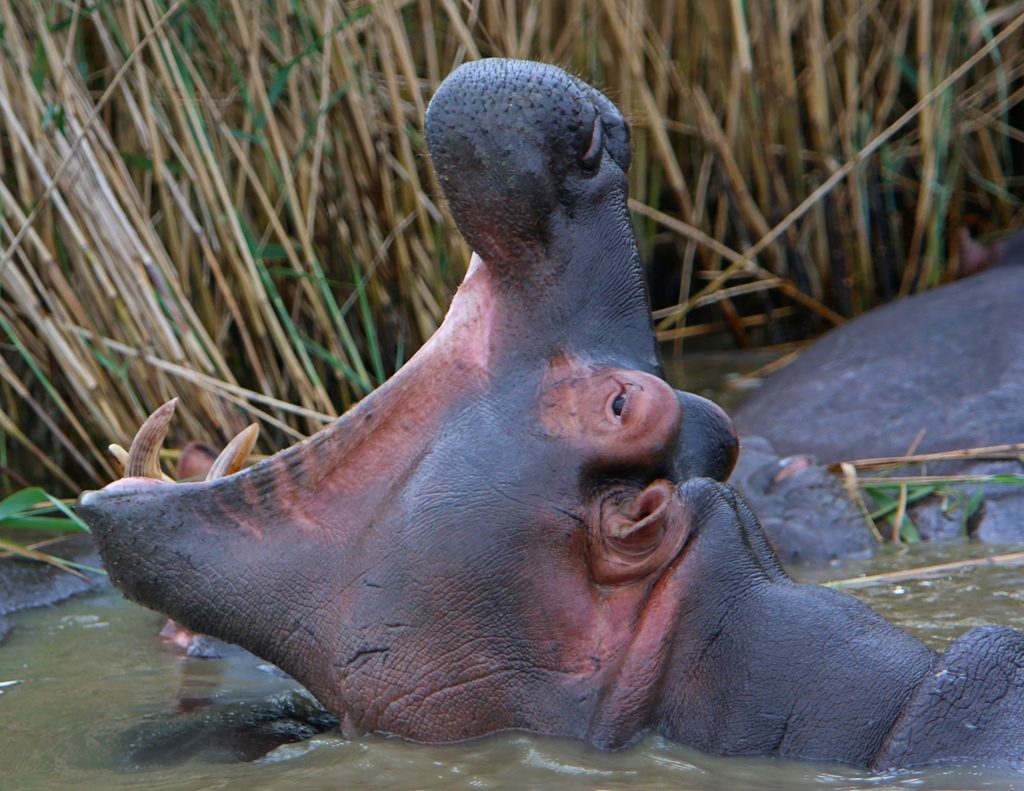 Hippopotumus. Photo by Kim & Cindy Risen ©.
Hippopotumus. Photo by Kim & Cindy Risen ©.
Just north of town is Cape Vidal, a unique reserve, protecting some of the most pristine sand forest and palm savanna in all of Zululand, and we’ll search for such special birds as the spectacular Crested Guineafowl, Klaas’ Cuckoo, Yellowbill, Scaly-throated Honeyguide, Blue-mantled Crested Flycatcher, the highly sought-after African Broadbill, and the attractive Lemon-breasted Canary, a scarce endemic only described to science in 1960.
We’ll return to St. Lucia for a bit of a break before dinner and our night drive into the iSimangaliso wetlands—if still offered—access is allowed only to prearranged night drives. In 2012 we saw two Leopards and a host of smaller animals on the nightdrive, in 2013 we saw THOUSANDS of antelope of seven species! and in 2014 we had Leopard and many antelope species. 2015 had Leopard and a fine selection of antelope…but most impressive was a cooperative Porcupine. In 2016 the Eastern Shores were open, but I’m hoping to get us into the more productive Western Shores. Night St. Lucia.
Day 15, August 27, 2018: St. Lucia to Eshowe. A final morning to find any species missing from the St. Lucia area before we begin our drive southward to Eshowe. We’ll stop enroute at the resort town of Mtunzini, home to Africa’s southernmost breeding population of Palmnut Vultures. We plan to arrive at Eshowe in the early afternoon hours. Ample time to get settled into the convenient Birds of Paradise Bed & Breakfast. I’ve stayed here our last five tours and I’ve found them to be perfect for us. Often there are good birds in the gardens to photograph and we’re only a few minutes from Dhlinza. Good meals, too. Something that experience has taught me not to take for granted! Night Eshowe.
Day 16, August 28, 2018: Eshowe, Dhlinza Forest, to Benvie. Early this morning we visit thick woodlands within the Dhlinza Forest Reserve to experience South Africa’s only forest canopy walkway. We’ll spend quality birding time from the elevated tower’s superb viewpoint. This will be our best chance to find the rare Delegorgue’s Pigeon (Eastern Bronze-naped Pigeon)—which often sits exposed on bare snags in the early morning. This beautiful forest reserve supports an avifauna combining both coastal and mistbelt bird species and we’ll search for African Goshawk, the rare Delegorgue’s Pigeon, Narina Trogon, Purple-crested Turaco, Crowned and often noisy Trumpeter Hornbill, Square-tailed Drongo, Chorister Robin-Chat, Gray Cuckoo-shrike and the highly endangered Spotted Ground-Thrush. We’ll begin our visit to the reserve by enjoying their canopy walkway and observation tower. Getting eye-level views of canopy birds is fun and, if the fig trees along the walkway are in fruit, photo ops of the turacos and hornbills are unbelievable!
Spotted Ground-Thrush. Photo by Kim & Cindy Risen ©.
Dhlinza’s trails usually get us close to Blue Duikers. Many of the ground birds can be found on the relatively open, mature forest floor. (Need to use flash photography!) The canopy walkway and tower is a blast, as mentioned above.
We’ll return to our B & B for a late breakfast before we transfer to our home for the next two nights, the beautiful and charming Benvie farm. We’ll arrive at the small town of Hilton and the historic Benvie Farm in the late afternoon. Benvie was established in 1882, by Scottish emigrant John Geekie and is well known throughout South Africa by both gardening and birdwatching fraternities. Geekie, a cabinet maker by profession, also loved trees, and he imported seedlings from around the world. Many of the trees which he planted are still standing today, including three giant eucalypts. The trunks of these Mountain Ash trees (Eucalyptus regnans) boast massive circumferences of more than 6.8 m , and are a rare sight in South Africa. Today the farms arboretum is managed by Geekie’s great grand daughter, and his descendants have continued the family tradition of cabinetry and furniture making.
If time allows, we may take a quick drive through Midmar Game Reserve, famous for its Black Wildebeest. Watching these unusual animals as they snort and strut around is truly an amazing experience. Other animals we should observe include Common Reedbuck, Plains Zebra, Red Hartebeest, Blesbok and, if we are very lucky, Porcupine or Aardvark. The moist grasslands and open marshes of the reserve support a variety of birds and we hope to see Spotted Thick-knee, Crowned and Wattled Lapwing and Blacksmith Plover. An after dark search for owls or flufftails is possible. Night Benvie Farm.
Day 17, August 29, 2018: Benvie, Karkloof & Howick Falls. After a relaxed morning birding the grounds and a delicious breakfast we will drive south toward Howick. Benvie’s one hundred and twenty-seven year old garden covers an area of about thirty hectares, and consists mainly of large conifers, rhododendrons and azaleas, all of which are bordered by a typical indigenous mist belt forest. The world-class garden features a walkway, about two kilometers long, directing visitors with a series of signs posted along the way. Here we have a good chance of seeing Orange Ground Thrush, Chorister Robin Chat, Olive Woodpecker, Grey Cuckooshrike, Knysna Turaco, White-starred Robin and Cape Parrot—which use the property as a nesting site. During early summer a variety of migrant species arrive at the farm. Most of these migrant birds belong to the cuckoo family and include Red-chested, Black, African Emerald, Klaas’s and Diderick Cuckoos. Forest Buzzard and Narina Trogon are also sighted regularly in and around the forest. Walking through the gardens here is like being inside a Monet painting! We’ll stay in the historic farmhouse and make ourselves at home amid the colorful blossoms. Owls and flufftails both occur in the forested areas adjacent to our guesthouse. We’ll make an effort to see them during our visit.
Orange Ground-Thrush. Photo by Kim & Cindy Risen ©.
We’ll begin our morning walking the grounds of Benvie searching for new species. Flowers, ponds, weaver colonies, birds and scenery are but a few of memorable sights. After breakfast, we’ll travel through the Karkloof, a range of forested hills near Howick, home to a number of uncommon and local birds restricted to Afro-montane forests. We will be searching for Southern African endemics such as Mountain Buzzard, Knysna Turaco, the highly endangered and endemic brown-headed form of Cape (Brown-necked) Parrot, the elusive Bush Blackcap—one of South Africa’s most sought after endemics, African Scrub-Warbler, Southern Tchagra, Olive Bushshrike, Swee Waxbill and Forest Canary, as well as many more widespread yet no less spectacular birds such as Rameron Pigeon, Olive Woodpecker, the uncommon Orange Ground-Thrush, White-starred Robin and Yellow-throated Wood-Warbler. Further up the Karkloof range, we visit a pristine area of upland grassland hosting Blue and Gray Crowned Cranes and, if we are lucky, Wattled Crane. Other species that we have a chance of locating are African Yellow-Warbler, Red-necked and Red-winged Francolin and Fan-tailed Grassbird. Additionally, this area is particularly good for a profusion of cisticolas including Pale-crowned, Cloud-scraping, Wing-snapping, Croaking, Zitting and Wailing Cisticolas. Black-winged Lapwing and Cape Longclaw also occur here but the star bird is undoubtedly the striking Buff-streaked Chat, an endemic wheatear that is breathtaking both in appearance and song. Mammal possibilities include Mountain Reedbuck and the sleek Oribi antelope. Night Benvie Farm.
Day 18, August 30, 2018: Benvie to Creighton. A final morning amid the quiet tranquility of Benvie, searching for any species that might have eluded us the previous days. We’ll have ample time to explore the many grasslands, wetlands and hillside forests as we travel to Creighton. We plan to make our way into one particular mistveld forest in the surrounding hills. Here we’ll find ourselves dwarfed by ancient, towering Yellowwood trees typical of this kind of forest and very important as a source of food and breeding site for Cape Parrots. This forest serves as an excellent site for the bird and a handful of other forest species. We’ll make our way to the edge of the forest where it is easiest to locate the calls and flight path of these rare parrots. It is estimated that there are only about 600 of these birds left and this combined with the constant threat of deforestation and a lack of scientific knowledge about the ecology of the bird, award this bird its endangered status. In the early evening we’ll arrive at the quiet town of Creighton. Night Creighton.
During our visit to this area, we’ll be staying at the delightful Smithfield House, home of Malcolm & Gail Gemmell. Malcolm is the provider for our four-wheel drive tour up Sani Pass and their garden and home cater to birders and offer some wonderful photographic ops. Great folks, great meals, great facility and good photography Night Creighton.
Days 19, August 31, 2018: Day trip to Sani Pass, Lesotho. Today we travel up into the tiny mountain kingdom of Lesotho in search of a handful of highly localized, highland endemics. In order to do this, we will transfer to 4X4 vehicles and make our way up the rugged and spectacular Sani Pass, birding enroute. The grassy slopes and rocky outcrops at the lower end of the pass are home to the bizarre Ground Woodpecker, Cape Rock-Thrush and Yellow Bishop, while stands of Protea bushes support the spectacular, endemic Gurney’s Sugarbird (belonging to a family endemic to Southern Africa), Greater Double-collared Sunbird and the dazzling Malachite Sunbird. As we approach the crest of the escarpment, we’ll be scanning the rocky scree along the roadsides for the stunning Drakensberg Rockjumper, Yellow-tufted Pipit, Sentinel Rock-Thrush and Drakensberg Siskin.
Drakensberg Rockjumper. Photo by Kim & Cindy Risen ©.
Atop the plateau, the steep slopes and rugged cliffs are replaced by gently undulating terrain and endless vistas of distant, blue mountains. Black Stork and Southern Bald Ibis may be found alongside the mountain streams, while Gray-winged Francolin, Red-capped Lark, Sicklewing Chat, African and Mountain Pipits, Yellow Canary and Cape Bunting prefer adjacent meadows. A number of birds more typical of the Karoo, such as Southern Gray Tit, Large-billed Lark, Karoo Prinia, Layard’s Warbler and Fairy Warbler reach the eastern limits of their range here in the Lesotho highlands. We’ll keep a careful watch skywards as Cape Griffon, the magnificent Lammergeier, Verreaux’s Eagle, Jackal Buzzard, Lanner Falcon and White-necked Raven are regularly seen overhead. Other animals of particular interest atop the “Roof of Africa” are the approachable Sloggett’s Ice Rat, the endemic Drakensberg Crag Lizard and colorful Southern Rock Agamas.
Sani Pass is AMAZING! Scenery and spectacular birds rule the day. When we arrive in Lesotho we’ll hike the scrubby terrain looking for some of the cooler birds. Photographing Drakensberg Rockjumpers, Ground Woodpeckers, Gurney’s Sugerbirds, proteas, Sloggett’s Ice Rats and the chance to see Eland, the world’s largest antelope species, grazing along steep hillsides.
Ground Woodpecker. Photo by Kim & Cindy Risen ©.
Our return to Malcolm and Gail’s farm will be in time to enjoy their gardens a bit or enjoy a brief rest before dinner. Night Creighton.
Day 20, September 1, 2018: Creighton, Xumeni Forest reserve, drive to Johannesburg. This morning we’ll depart early to visit Xumeni Forest reserve. A rich remnant of Afro-montaine forest, Xumeni holds many large forest species that have disappeared with their habitat from the African landscape. Here we find huge Yellowwood and White Stinkwood trees amid the forested hillsides. Avian top billings go to Cape Parrot, Knysna Turaco, Orange Ground-thrush, Barratt’s Warbler and a host of forest species.
Leader: Kim Risen & Rick Bowers
| Intro | Itinerary | Tour Pricing and Information | Gallery | Birdlist | Registration |

